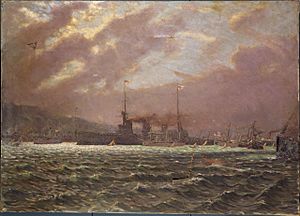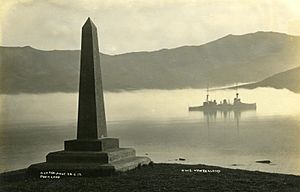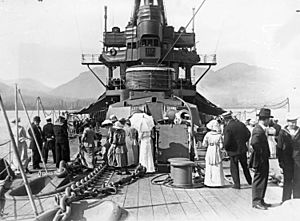HMS New Zealand's 1913 circumnavigation facts for kids
The HMS New Zealand's 1913 world tour was a very special journey. It was the first time a huge warship like a battlecruiser from the Dreadnought era sailed all the way around the world. This amazing trip happened between February 6 and December 8, 1913. The main reason for the trip was to thank the people of New Zealand. They had generously paid for this powerful ship, HMS New Zealand, to be built for the Royal Navy. It was a way to "show the flag" and celebrate the strong connection between New Zealand and Britain.
Contents
Building and Getting Ready
In March 1909, the government of New Zealand made an incredible offer. They wanted to pay for a new battleship for the Royal Navy. Later, the British Navy suggested a battlecruiser instead, which is a very fast and powerful warship. The building of HMS New Zealand began in June 1910.
By October 1912, the ship was almost ready. It started its sea trials, which are tests to make sure everything works perfectly. On November 19, 1912, the ship officially joined the Royal Navy.
Soon after, plans were made for the ship to visit New Zealand. Everyone wanted to make sure the trip was well-planned. A nine-month journey was decided upon by the end of 1912. The ship could not use the Suez Canal because it was too deep for the canal at that time. So, it had to sail around South Africa.
Before the ship left, King George V himself visited the battlecruiser. He was joined by important people like Winston Churchill and New Zealand's Minister of Finance and Defence, James Allen. This visit happened on February 5, 1913.
The Big Journey Begins
Right after the King left, New Zealand took on a lot of coal. It then left Portsmouth on February 6, 1913. As the battlecruiser sailed south, it stopped to refuel with coal in places like St Vincent and Ascension Island.
The ship arrived in Cape Town, South Africa, on February 28. After visiting Simon's Town and Durban, it continued its journey.
Australia and New Zealand
On April 2, New Zealand reached Melbourne, Australia. Other Australian warships, like the cruiser HMAS Melbourne and several destroyers, greeted it. The journey from Durban had used up almost all of the ship's coal. So, 750 crew members worked for 20 hours to load 3,000 tons of fresh coal.
Because the ship was so big and heavy with coal, it couldn't dock right next to a pier. It stayed moored offshore, and about 300 New Zealanders living in Australia were ferried out to visit it.
New Zealand then sailed to Wellington, New Zealand, arriving on April 12. This was a huge event for the country! Over 98,000 people visited the ship in Wellington alone. They were taken by steamers to see "our Dreadnought," as they called it. The ship's crew had a very busy time attending many events and celebrations.
The ship traveled all around New Zealand, visiting many towns:
- North Island: Napier, Gisborne, Auckland, Wanganui, Russell.
- South Island: Lyttelton, Akaroa, Timaru, Otago (moored offshore), Bluff, Milford Sound, Greymouth, Westport, Nelson, Picton.
While in New Zealand, the ship received many gifts. Two special greenstone hei-tiki (pendants) were given, believed to protect against bad luck. The ship's commander, Halsey, also received a Māori piupiu (a warrior's skirt made from flax).
By the time New Zealand left Auckland for Fiji on June 28, an incredible number of New Zealanders had visited the ship. Estimates say between 368,000 and 378,000 people came aboard! Many more saw the ship from the shore or from boats. At that time, New Zealand's total population was about one million people.
So far, the battlecruiser had sailed about 19,216 miles and used over 16,600 tons of coal.
Across the Americas
After leaving New Zealand, the battlecruiser reached Suva, Fiji, on July 1. Then, it sailed across the Pacific Ocean to Honolulu, arriving on July 12. Here, it took on more coal and fuel oil for the long journey ahead.
On July 23, the ship arrived in Esquimalt, Canada, on Vancouver Island. While in Canada, New Zealand took part in a boat race with ships from the US Navy.
Leaving Vancouver on August 9, New Zealand sailed south. It stopped at several places in Mexico, including Mazatlán, Acapulco, and Salina Cruz. About 600 Mexicans visited the ship in Mazatlán. It then reached Panama City and later Callao in Peru on September 8.
New Zealand spent two months visiting South America. This part of the trip was important for showing off Britain's advanced naval technology. The ship visited Valparaíso in Chile, then sailed through the Strait of Magellan to Punta Arenas. It continued to Montevideo and Rio de Janeiro.
The ship then headed north, stopping at Trinidad (where it was the first warship to take on oil from there), Dominica, Jamaica, Grenada, and Bermuda. Its final stop in the Americas was Halifax, Nova Scotia, from November 21 to 30. From there, it sailed across the Atlantic Ocean.
New Zealand finally arrived back in Portsmouth on December 8, 1913.
The ship had sailed an incredible 45,320 miles! It had used over 31,800 tons of coal. More than 500,000 people had visited the ship during its journey. This was the longest voyage ever made by a dreadnought-era warship at that time. The trip was a huge success, and the ship's commander, Halsey, was even knighted for his excellent work.
Another Trip Around the World
New Zealand made a second trip around the world between February 1919 and February 1920. This time, it carried Admiral John Jellicoe. He was inspecting naval defenses in India, Australia, New Zealand, and Canada. This second journey was shorter, about 33,514 nautical miles, because the ship could now use the Panama Canal to cross between the Pacific and Atlantic Oceans.
Other famous Royal Navy ships, like HMS Hood and HMS Repulse, also completed a world tour in 1923–24.
See also
- List of circumnavigations




